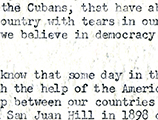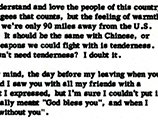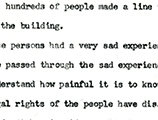The Cuban Experience in Florida: Revolution and Exodus
Lesson Plans
Letters to the Cuban Refugee Assistance Program, 1961-62
Background Information
These letters, written by Cuban refugees to the staff of the Cuban Refugee Assistance Program (CRA), provide insight into the refugee experience in the United States. Since all of these individuals worked for the CRA, they also demonstrate how Cubans interacted with the CRA and the impact of the program on the Cuban community.
The CRA provided health, employment and educational services to Cuban refugees upon their arrival in the United States. The program, approved by President John F. Kennedy in 1961, was administered in Florida by the state’s Department of Public Welfare until 1974.
The CRA was an unprecedented effort brought about by the mass exodus of Cubans from their homeland following the Revolution of 1959. From the early 1960s to the mid-1990s, more than one million Cubans immigrated to the United States. The majority settled in South Florida.
At the national level, the CRA was an important component of U.S. foreign policy during the Cold War. The U.S. hoped that programs like the CRA would help improve the reputation of the American government around the world. The CRA also allowed the U.S. to oppose the government of Fidel Castro by strengthening the Cuban exile community.
At the local level, the CRA helped alleviate social and economic problems created by the influx of Cuban refugees into Miami and South Florida. If not for federal assistance under the CRA, Florida and especially Miami-Dade County could not have assumed the financial costs of the Cuban refugee crisis.

Letter from Gustavo Alonso de la Torre, August 4, 1961
De la Torre found a teaching job in Pennsylvania.

Letter from Ana Anders, July 26, 1961
Anders worked as a medical social worker in Cuba before coming to the United States.

Letter from Manuel Minagorri, November 27, 1962
Minagorri explains the uncertainty Cuban refugees face upon arriving in the United States.

Letter from Joaquin Miranda, May 20, 1961
Miranda relates what it means to him to live in the United States.
Use to Illustrate:
- The Cuban refugee experience, in general and with the Cuban Refugee Assistance Program.
- The response of the United States government and the state of Florida to the Cuban refugee crisis.
Questions for Students
- How did Cuban refugees respond to the Cuban Refugee Assistance Program?
- How did Cuban refugees describe the Cuban government and the impact of the Revolution? How did they describe their experience in the United States?
- What can these letters tell about the impact of the CRA on the lives of the refugees?
Sample Answers
- Based on the letters provided here, Cuban refugees responded positively to the Cuban Refugee Assistance Program. They expressed gratitude for the assistance they received from the United States government.
- Many Cuban refugees expressed anger at Fidel Castro and the revolutionary government. In the letters provided here, refugees lament the lack of freedom in Cuba, but applaud their new-found freedom in the United States.
- The CRA had a significant impact on Cuban refugees, especially in providing healthcare, education and employment assistance. (Students should elaborate further based on the contents of the letters.)
Additional Relevant NGSSS
- SS.912.A.6.15: Examine key events and peoples in Florida history as they relate to United States history.
- SS.912.A.7.16: Examine changes in immigration policy and attitudes towards immigration since 1950.
- SS.4.A.8.2: Describe how and why immigration impacts Florida today.
- SS.912.A.7.11: Analyze the foreign policy of the United States as it relates to Africa, Asia, the Caribbean, Latin America, and the Middle East.
- SS.912.W.8.2: Describe characteristics of the early Cold War.
- SS.7.C.4.3: Describe examples of how the United States has dealt with international conflicts.

 Listen: The World Program
Listen: The World Program
